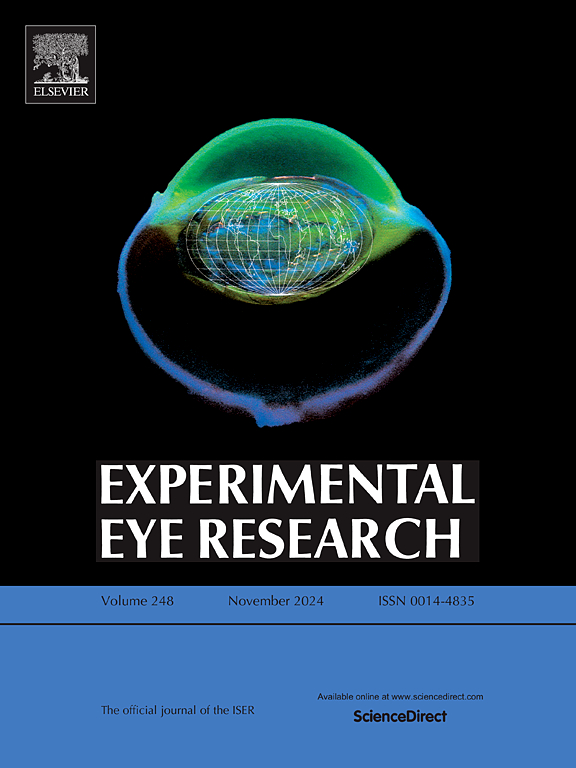富马酸二甲酯通过抑制发热和细菌毒力减轻假中间葡萄球菌诱发的细胞损伤。
IF 3
2区 医学
Q1 OPHTHALMOLOGY
引用次数: 0
摘要
病原菌对各种临床抗生素的耐药性是治疗细菌性角膜炎的主要问题。富马酸二甲酯(DMF)对真菌性角膜炎有良好的抗真菌和消炎作用,但对细菌性角膜炎的作用尚不明确。本研究旨在探讨 DMF 的抗炎和抗菌作用。通过犬角膜上皮细胞(CCECs)胞内感染假中间葡萄球菌(S.pseudintermedius)构建了热变态反应模型,并加入 200 μM DMF 以探索其功能。利用 Western 印迹、ELISA、免疫染色、流式细胞术、qRT-PCR 和细菌计数来检测 NLRP3-GSDMD 信号通路、毒力基因和氧化介质的表达。用不同浓度的 DMF 处理 111 株临床角膜炎分离株或假角膜炎奈瑟菌,以检测细菌的生长和生物膜的形成。加入 DMF 后,NLRP3-GSDMD 通路受到抑制,而 NRF2 通路则被激活,这导致了热变态反应率、细胞内细菌数量和 ROS 含量的下降。此外,DMF 还能阻断与伪中间体感染相关的毒力基因 ebpS、hlgB、siet、lukS-I、PVL、icaA、icaD、spsD 和 spsL 的 mRNA 表达。此外,DMF 对临床分离株的生长和伪中间肠杆菌生物膜的形成具有浓度依赖性抑制作用。总之,我们的研究结果表明,DMF 可抑制脓毒血症和各种临床分离菌的生长,是一种具有消炎和抗菌特性的新型眼科药物。本文章由计算机程序翻译,如有差异,请以英文原文为准。
Dimethyl fumarate alleviates Staphylococcus pseudintermedius-induced cell damage by inhibiting pyroptosis and bacterial virulence
The resistance of pathogenic bacteria to various clinical antibiotics is the major problem in treating bacterial keratitis. Dimethyl fumarate (DMF) has good anti-fungal and anti-inflammatory effects in fungal keratitis, but its effect on bacterial keratitis is unclear. This study aims to investigate DMF's anti-inflammatory and antibacterial effects. The pyroptosis model was constructed by intracellular infection of canine corneal epithelial cells (CCECs) with Staphylococcus pseudintermedius (S. pseudintermedius), and 200 μM DMF was added to explore its function. Western blot, ELISA, immunostaining, flow cytometry, qRT-PCR, and bacterial counts were used to examine the expression of the NLRP3-GSDMD signaling pathway, virulence genes, and oxidant mediators. 111 clinical keratitis isolates or S. pseudintermedius were treated with different concentrations of DMF to detect bacterial growth and biofilm formation. Adding DMF resulted in the inhibition of the NLRP3-GSDMD pathway while activating the NRF2 pathway. This led to a decrease in pyroptosis rate, intracellular bacteria count, and ROS content. Additionally, DMF blocked the mRNA expression of virulence genes ebpS, hlgB, siet, lukS-I, PVL, icaA, icaD, spsD, and spsL associated with S. pseudintermedius infection. Furthermore, DMF demonstrated concentration-dependent inhibition of the growth of clinical isolates and the formation of S. pseudintermedius biofilm. In conclusion, our results indicate that DMF can inhibit pyroptosis and the growth of various clinical isolates, making it a novel ophthalmic drug with anti-inflammatory and antibacterial properties.
求助全文
通过发布文献求助,成功后即可免费获取论文全文。
去求助
来源期刊

Experimental eye research
医学-眼科学
CiteScore
6.80
自引率
5.90%
发文量
323
审稿时长
66 days
期刊介绍:
The primary goal of Experimental Eye Research is to publish original research papers on all aspects of experimental biology of the eye and ocular tissues that seek to define the mechanisms of normal function and/or disease. Studies of ocular tissues that encompass the disciplines of cell biology, developmental biology, genetics, molecular biology, physiology, biochemistry, biophysics, immunology or microbiology are most welcomed. Manuscripts that are purely clinical or in a surgical area of ophthalmology are not appropriate for submission to Experimental Eye Research and if received will be returned without review.
 求助内容:
求助内容: 应助结果提醒方式:
应助结果提醒方式:


